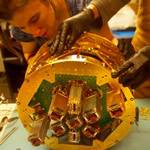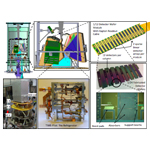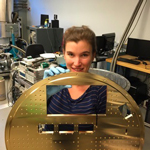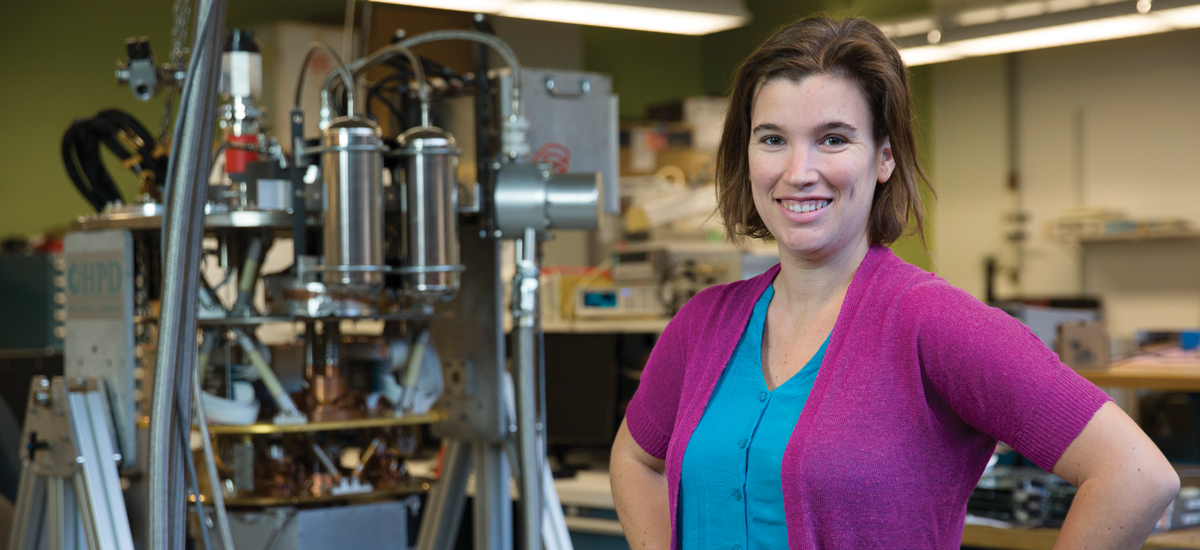Abigail Crites
KISS Gives Fellows the Freedom to Explore
Observational cosmologist Abigail Crites designs and assembles instruments aimed at understanding how the early Universe evolved. She currently spends her days building and testing components of the Tomographic Ionized-Carbon Mapping Experiment (TIME), a spectroscopic camera that will map the abundance of ionized carbon in galaxies that formed less than one billion years after the Big Bang. During this relatively mysterious period in the history of the Universe — known as the Epoch of Reionization — photons emitted by those early galaxies collided with nearby neutral hydrogen and helium atoms, stripping them of electrons. “Eventually you have so many sources with so many photons that are ionizing the matter around them that you basically have ionized the whole Universe.” By measuring the distinct signature of these faint dwarf galaxies, Crites and the TIME team hope to constrain the rate of star formation during this poorly-understood era.

Abigail's research is focused on the development of millimeter wavelength instrumentation to study the early universe. She is currently working on the TIME-PILOT instrument, a mm-wavelength spectrometer designed to do intensity mapping of c+ from the epoch of reionization, when the first stars and galaxies turned on and ionized the neutral hydrogen in our universe. She is also a member of the South Pole Telescope Collaboration.
“My role on TIME is to design and fabricate and integrate the mechanical and thermal parts of the camera,” she says. To catch minute signals, the detector has to be cooled down to a quarter of a degree above absolute zero — about -459°F! “Thermal noise from nearby hot things actually is larger than the tiny, tiny signals we’re trying to measure, so we have to have very, very low noise detectors, and that means cooling them down to very low temperatures. So a lot of the work that I do is cryogenics.” Using specialized refrigerators and layers upon layers of shields, Crites cools down the detectors at the center of the instrument to test its functions, warming it back up to “try again if it didn’t work the first time.”
“
The KISS fellowship really allowed me to take this technology and apply it to a different science goal and a different period in the history of the universe.
”
TIME is part of an innovative effort to apply established techniques to a new problem, and that spirit of exploration is evident in the path that Crites has taken in her research. When she first arrived at Caltech in 2013 as a KISS Postdoctoral Fellow, she expected to extend her graduate work on the cosmic microwave background, a relatively mature field of study. But the chance to work on the understudied Epoch of Reionization presented a new subject for Crites, and her KISS fellowship gave her the opportunity to pursue it. “The KISS fellowship really allowed me to take this technology that we have been developing for a well-known field and apply it to a different science goal, basically, and a different period in the history of the universe.”

TIME-Pilot instrument will be housed in an existing closed-cycle 4 K– 1 K–300 mK cryostat, with an enlarged cryogenic volume to allow insertion of the spectrometer stacks and optics. The 32 waveguide grating spectrometers are assembled into two stacks of 16, they couple the same 1-D linear field on the sky via an array of feedhorns and single-polarization waveguide feeds illuminated through a polarizing grid.

The dispersed light is detected with twelve 2-D arrays of TES bolometers which span the spectrometer stacks with a total of 1931 detectors. The TESes are similar to those built at JPL for CMB polarimetry as well as space-borne spectroscopy. Eleven 150 GHz broadband channels view the same sky as the spectrometers via a dichroic filter, and will be used in surveys of the kSZ effect in galaxy clusters. The spectrometers and detectors are cooled with a custom dual-stage 250-mK / 300-mK refrigerator which has been built and tested.
Up For A Challenge
One challenge Crites faces is the absence — at this early stage — of well-defined theoretical predictions for the observations she hopes to make. “If we are able to measure these signals, it could open an entirely new field of astronomy and a new way to study the Epoch of Reionization.” These measurements would complement radio telescope observations and establish ionized carbon mapping as a viable new tool to probe this unknown period. While some in the astrophysics community remain skeptical, Crites is up for a challenge. “I love the idea of trying something that is hard. You don’t really know if it’s going to work for sure. You don’t know if the signals are going to be very, very bright or very faint.” She relishes the opportunity to pioneer these new observations. “This is kind of getting to step back to the early days of a field and be the one that’s like, ‘I’m going to try it, even though not that many people are doing it.’ And just see where it goes.”
“
KISS is actually pretty magical. I think some people call it the KISS family, and that really makes sense.
”

The Big Picture
From allowing her the freedom to pursue a new research area to its ever-present attitude of empowerment, Crites credits KISS for encouraging her to become an independent researcher. “Where KISS stands out is that it allows you to think about not just the next incremental step but the next big step that we’re going to make,” she says. “It’s really hard to make huge advances if you don’t even have the time or space to kind of step back, and I think KISS gives you the time and the space to think about the big ideas.”
“
KISS gives you the time and the space to think about the big ideas.
”
Abigail Crites
That big-picture mentality is one reason why Crites continues to attend KISS events, even after her two-year fellowship came to an end in 2015. “KISS is actually pretty magical. I think some people call it the KISS family, and that really makes sense.” Continuing her research at Caltech as a National Science Foundation Postdoctoral Fellow, she finds inspiration in the network of scientists and engineers brought together by KISS. “They also give me new ideas to think about, where I could go with my research in the future. The people that we meet, the conversations that I have through KISS really enhance my science, and that is why I stay connected.”